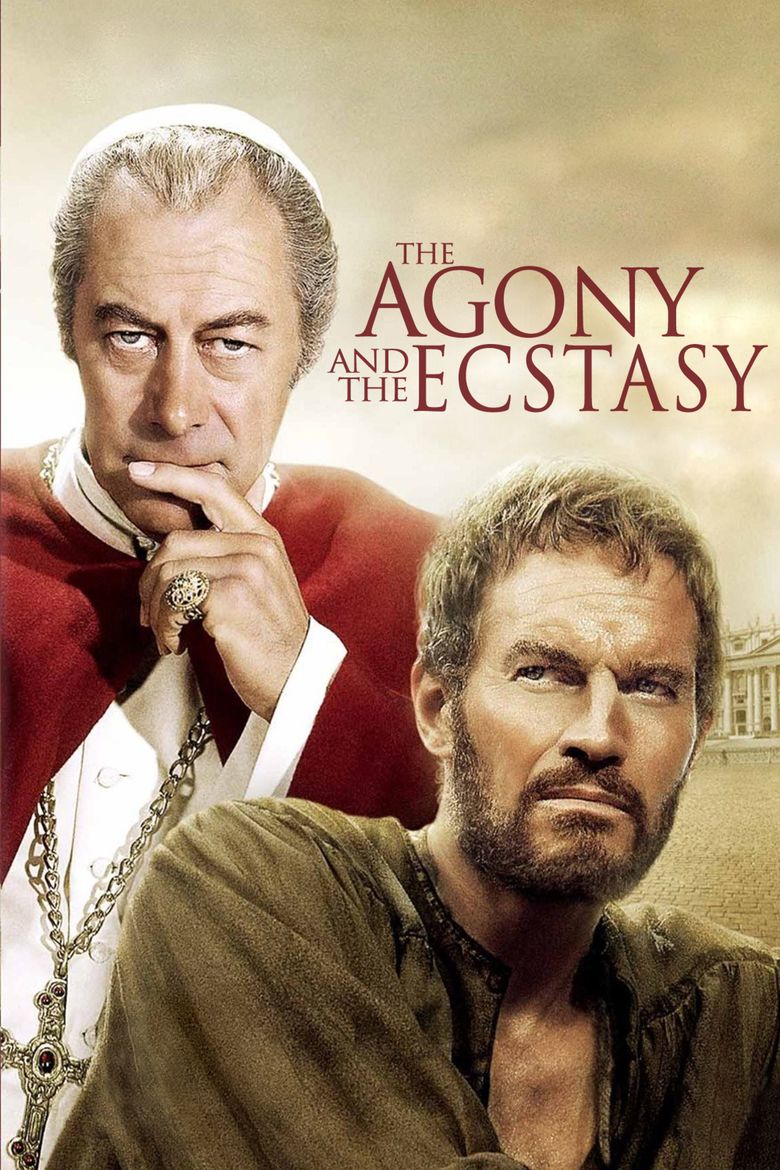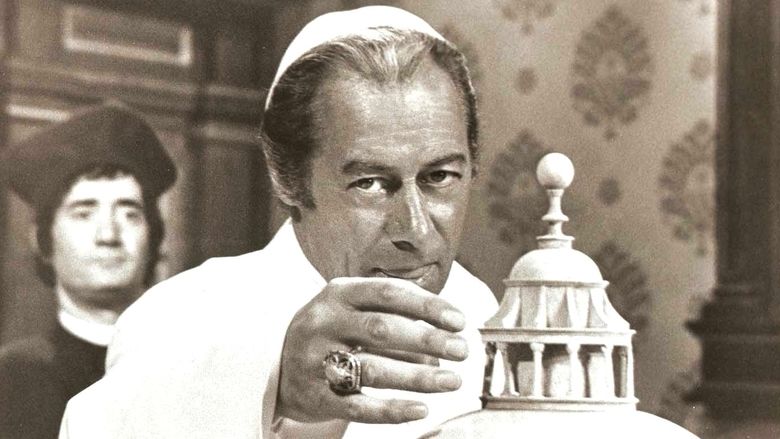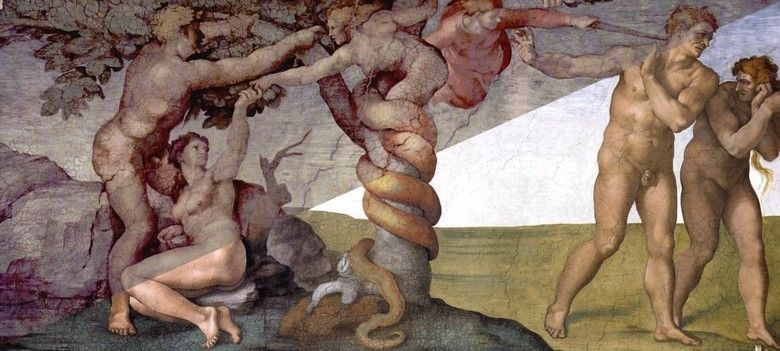The Agony and the Ecstasy (film)
8.2 /10 1 Votes8.2
86% Rotten Tomatoes Duration Country United States | 7.2/10 IMDb 4.4/5 Amazon Genre Drama, History Language English | |||||||||||||||||||||||||||||||||
 | ||||||||||||||||||||||||||||||||||
Release date October 7, 1965 (1965-10-07) Cast (Michelangelo), (Pope Julius II), (Contessina de'Medici), (Bramante), (Duke of Urbino), (Giovanni de' Medici) Similar movies The Hood Samaritan , Leopard Vision Vol.1 , Revelation - The Bride, The Beast & Babylon , Marching to Zion , Mission: Impossible III , The Godfather: Part III Tagline From the age of magnificence comes a new magnificence in motion pictures. | ||||||||||||||||||||||||||||||||||
The Agony and the Ecstasy is a 1965 American film directed by Carol Reed, starring Charlton Heston as Michelangelo and Rex Harrison as Pope Julius II. The film was partly based on Irving Stone's biographical novel of the same name. This film deals with the conflicts of Michelangelo and Pope Julius II during the painting of the Sistine Chapel's ceiling. It also features a soundtrack co-written by prolific composers Alex North and Jerry Goldsmith.
Contents

The film was shot in Todd-AO and Cinemascope versions. The Todd-AO version was used for the DVD release because of its superior picture quality.

Synopsis

Michelangelo Buonarroti (Charlton Heston) is a renowned sculptor of the Republic of Florence in the early 16th century. When Pope Julius II (Rex Harrison) commissions him to paint the Sistine Chapel, Michelangelo resists because he finds the ceiling's paneled layout of the Twelve Apostles uninspiring. Nonetheless, he is forced into taking the job. During the initial attempt, Michelangelo is discontent with the results and destroys the frescoes. He flees to Carrara and then into the mountains, where he finds inspiration from nature.

Michelangelo returns and is allowed to paint the entire vault in a variety of newly designed biblical scenes. The work proceeds nonstop, even with mass in session, as months turn to years. Michelangelo's work is threatened when he collapses due to fatigue. He is nursed back to health by Contessina de' Medici (Diane Cilento), daughter of his old friend Lorenzo de' Medici. After recovering, Michelangelo returns to work after learning he is at risk of being replaced by Raphael (Tomas Milian).
Meanwhile, the Papal States are threatened during the War of the League of Cambrai. Preparing for battle and having reached the limits of his patience, the Pope terminates Michelangelo's contract. Raphael, impressed with the work in progress, asks Michelangelo to show humility and finish the ceiling. When the injured and weakened Pope returns, Michelangelo pleads for him to restore the patronage. Though the Pope believes an invasion of Rome is inevitable, he raises the money needed to resume work on the ceiling.
One night, Michelangelo finds the ailing Pope inspecting the portrait of God in The Creation of Adam, which the Pope declares "a proof of faith." He then collapses and becomes bedridden. Though everyone assumes that the Pope will die, Michelangelo goads him into having the will to live. The tide of war turns in favor of the Papal States, as allies pledge to assist the Pope.
A mass is held in which the congregation is shown the completed ceiling. After the ceremony, Michelangelo asks to begin carving the Pope's tomb. Realizing he has a short time to live, the Pope agrees. Together, the men admire the masterpiece of the Sistine Chapel.
Cast
Production
The film's production schedule ran from June 8th, 1964 to September, 1964.
Philip Dunne wrote the screenplay for the film in 1959, around the time the original book by Irving Stone was published. The movie was originally supposed to have been filmed in 1961, directed by Fred Zinnemann and starring Burt Lancaster, but production was delayed for three years. Laurence Olivier was supposedly the first choice for Pope Julius II, but was unavailable. Spencer Tracy was then offered the role of the Pope before Rex Harrison was cast. When it came time to film the feature, the Sistine Chapel could not be used and so it was recreated on a sound stage at Cinecittà Studios, Rome, Italy. During the production, Rex Harrison and Charlton Heston did not get along. Twelve years later, while filming The Prince and the Pauper, Harrison avoided Heston completely.
According to his diary, Heston was interested in playing Michelangelo before any studios decided to produce the movie. Once cast in the part, he was excited to act under Reed, who had directed The Third Man (1949). Heston felt that this would be the movie to resurrect Reed's directorial reputation, describing it as having the best audience-preview responses than any film he had ever seen. However, it only did modest business at the box office.
Reception
The film grossed around $4,000,000 during its US theatrical run in 1965. It later went on to make about $8,166,000 worldwide in rentals.
It currently holds an 86% on Rotten Tomatoes and a 7.2 out of 10 stars on IMDB.
Bosley Crowther at The New York Times felt the film was, "not a strong and soaring drama but an illustrated lecture on a slow artist at work." He sympathized with the Pope and his mounting impatience with Michelangelo, criticizing Heston's acting as lacking any warmth to endear him to the audience. Furthermore, he believed the script suffered from being "wordy."
In a 2013 retrospective review in The Guardian, Alex von Tunzelmann noted that the film's "intent to inform is laudable, but a fictional film should really be able to convey its subject without a lecture," and echoed Crowther's observation that "the screenplay goes heavy on the dialogue, light on the action." She concluded the film would have been more interesting "if it were told with a lot more humour and a lot less prudishness."
James Plath of Movie Metropolis was more positive, saying that "For some viewers, the agony will be watching Charlton Heston (over)act, and the ecstasy Rex Harrison. But it IS refreshing for a period film to cover such new and (pun intended) artistic ground."
Awards
The film was nominated for five Academy Awards:
It was nominated for two Golden Globe awards:
It won two awards from the National Board of Review:
It won the Best Foreign Film from the David di Donatello Awards.
References
The Agony and the Ecstasy (film) WikipediaThe Agony and the Ecstasy (film) IMDbThe Agony and the Ecstasy (film) Rotten TomatoesThe Agony and the Ecstasy (film) Amazon.comThe Agony and the Ecstasy (film) themoviedb.org
